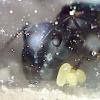Phoenix worms are actually soldier fly larvae.
Here is what I found:
Housing and substrate:
Pheonix worms/Black soldier flys do best in tall housing as opposed to shallow housing so things like a vase, cookie jar or a small bathroom works well. The flys should have sticks and twigs in the top of the enclosure to allow for resting and sleeping.
Substrate should be made up of old leaves, compost and if possible animal manure (such as horse and cow manure) (to avoid the smell leave the manure out to dry then just moisten a small part of the underneath for them to eat).
Food and water:
The larvae will eat old leaves and animal manure if kept as compost. They may also eat vegetable scraps if given the option and will gut load of fruits.
They don't generally need water however some people like to hang up leaves of lettuce for the adults to drink water from. I will add here, whilst the Flies do have a mouth they are not made for eating, it is purely for drinking, so there is no need to give them food.
Temperature and humidity:
Phoenix worms do best at 15-20C however the flys are best at 12-15C, the best way to maintain these temps is to use a tall enclosure, keep it in a cool-ish room and have a heat mat on the bottom for the worms so only a little amount of the heat rises to the top for the flys but all of them are kept at the right temperature. Humidity isn't very important at all - best kept below 50% however the pupae's will appreciate being taken out and put into a more humid (60-70%) tub until close to "hatching".
Breeding:
Hardly anything is needed for breeding, just male + female flies and somewhere for them to lay eggs. The best thing for this is to get a mug, put some organic compost into it and add water, compress it as much as possible and leave it there for a minute or two and compress again, keep doing this until you can't compress it anymore, once done turn it out of the mug and put into the enclosure on the floor or get some animal manure and leave it out on the bottom, you are more likely to have more sucess with the animal manure. And then probably the most important thing - room! The flys need to be able to fly for a foot or two as they mate whilst flying, the good thing is they don't a massive amount of room as it is over in with seconds. Males die shortly after mating, females live about a week longer.
Life Cycle:
Adult/Fly: Black Soldier Flies are 15-20mm long and have dusty-grey wings. Males have a bronze coloured abdomen and females have 2 segements of the "abdomen" that are red in colour.
Egg: Eggs are 1mm long and are laid in clusters of 300-500 and have a 96% hatch rate.
Larvae/Pheonix Worms: Larvae of the Black Soldier Fly otherwise known as the Phoenix worm are small, plump worms that go through a series of "instars" before turning to pupae, the last instar being a red/brown colour. Usually growing up to about 18mm they make a good livefood.
Pupae: The pupa develops within the darkened skin of the last larval instar. The pupa is roughly 1/3 the length of the puparium.
Generaly maintanence:
Nothing really is needed apart from if feeding veggies removing any that are old/mouldy. Just keep them fed and happy and all should be fine.
Alternative substrate:
In the wild, they can colonize virtually anything organic, from carcasses to animal waste, but they tend to prefer decaying vegetation/fruit that has begun to ferment.
1 cup - instant oats
1 cup - bran or wheat
Half cup - baked, grated/blended veggies
2 TBSP - honey
1/3 cup - boiled, extremely fine cut or blended cooked meats
1 cup - rice puffs
If you have a rabbit, add some rabbit poop as well.
The Smell
The neat thing about soldier flies is that once they colonize a food source, the grubs drive off any other species of flies from laying their eggs by releasing pheremones. This same pheremone calls out to more adult flies, eventually providing you with an unlimited source of eggs as long as adults are out. A pheremone laced mixture of grubs and compost from a mature colony can then be used to seed other buckets/composters, immediately calling in fresh egg-laden females. Once a food source is colonized, there is virtually no smell unless you stick your nose directly into the composter. Even then, the smell isn't bad, it's merely quite earthy and strong.




















